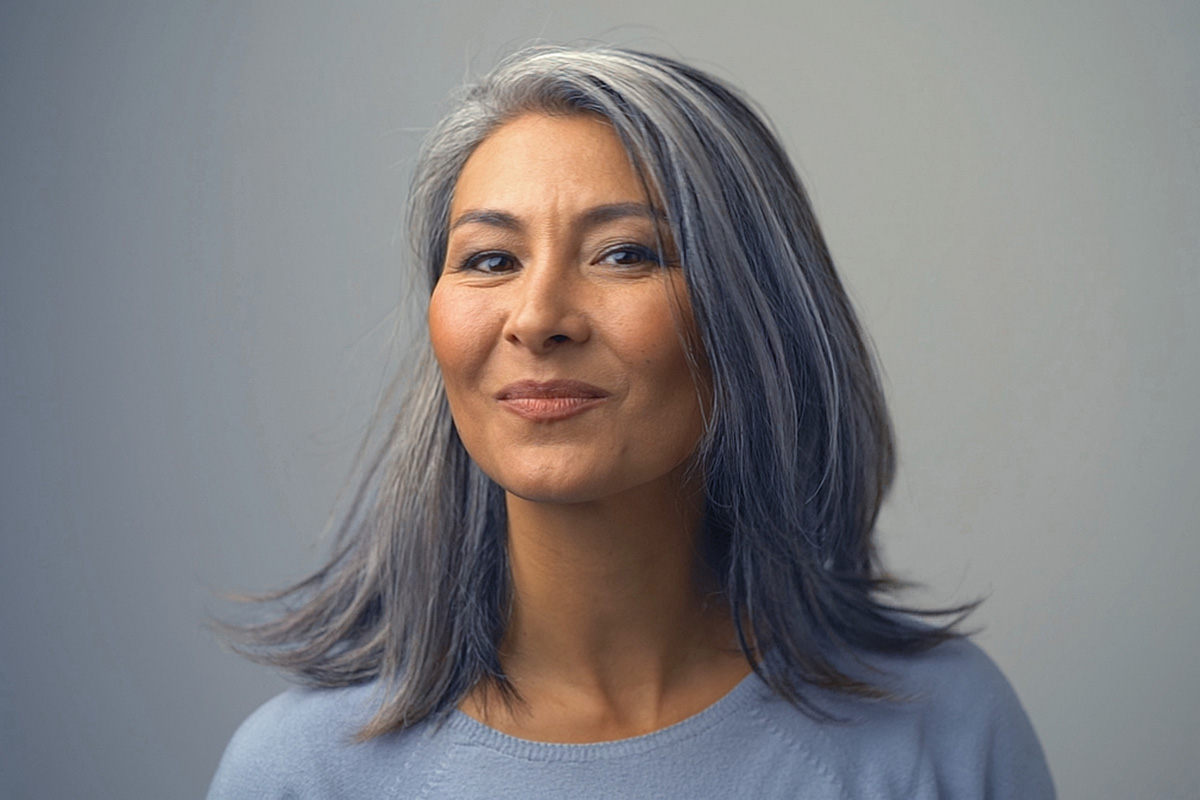Women of Color: The Many Shades of Menopause
For many women of color in the United States, the menopause transition can be more challenging than their white counterparts. Symptoms may be more frequent, more severe, and last longer. Women of color are also at a greater risk of health disparities and other health inequities. Being a woman and also one of color significantly increases the likelihood of being subjected to medical gaslighting, which is seen (relatively) less in white women and certainly much less in men.
To get a broad overview of the many shades of menopause, you can start here. If you’d like to dive into more details about a specific group, then click the section below.
Menopause for Women of Color
Despite a more challenging menopause experience for women of color, the number, breadth, and depth of studies are not as robust for women of color. That’s because much of the focus of scientific and medical funding and research in women’s health, both broadly as well as menopause, has historically been focused on non-Hispanic white women. Studies investigating menopause in multiracial and multiethnic women are even more rare.
Although there has been a recent acknowledgment of the gap in funding and a greater allocation of resources, much work remains to meet the needs of women+ who will universally experience this a stage of life!
That’s why pausitive health is talking about the menopause journey women of color may experience and sharing the latest research and information so you know what to expect during this time of transition.
The doctor you’ve had all your life may potentially not be your best companion on your menopause journey. Many healthcare practitioners receive insufficient training, so you may need to search for one with specific training and expertise in managing menopause if you feel your needs are not being met.
It’s also essential to be knowledgeable about how menopause may affect your life, as well as potential treatment options (hormonal and non-hormonal), and to surround yourself with a good support system from your friends and family to a partner/spouse.
Learning as much as you can and taking action proactively can pay big dividends, both now and in the future.
Chronic stress and trauma
are related to more severe menopause symptoms and a greater risk of cardiovascular disease during the transition.
What influences your menopause journey?
There are several factors that appear to impact or contribute to some of the menopausal differences seen between races and across ethnic groups. They include:
- age
- social determinants of health (SDOH), e.g., socioeconomic status, education level, exposure to environmental toxins, access to safe neighborhoods with accommodations for physical activity, clean air and water, and healthy food
- geographic locale
- underlying medical conditions
- lifestyle
- time of onset of very first period
- chronic stress
- history of trauma
- degree of acculturation
- racism (“involves one group having the power to carry out systematic discrimination through the institutional policies and practices of the society and by shaping the cultural beliefs and values that support those racist policies and practices”)
- discrimination (“the unequal treatment of members of various groups based on race, gender, social class, sexual orientation, physical ability, religion and other categories”)
In the United States, a study of more than 22,000 menopausal women showed geographic differences in a woman’s menopause journey. Southern women reported menopause nearly 11 months earlier than Northeastern women and at least six months earlier than women throughout the U.S., even after controlling for race, reproductive history, smoking, socioeconomic status, physical activity, and history of cardiovascular disease.
Both racism and discrimination can and often do negatively impact several of the other factors – socioeconomic status, education level, ability to live a healthy lifestyle, geographic locale, and the presence of underlying conditions. And socioeconomic status and the ability to live a healthy lifestyle can impact the age of onset of the first period.
Living in neighborhoods with higher concentrations of air pollution and less access to green space has been associated with an earlier age of onset of menopause. And being unhoused leads to more symptoms.
A lower socioeconomic status has been linked to a younger age of onset of menopause, issues with sleep, more frequent vasomotor symptoms (VSMs) like hot flashes, night sweat, and palpitations, and subclinical atherosclerosis during the transition, which would increase the risk of cardiovascular disease such as stroke and heart attack. And being uninsured makes menopause symptoms more challenging.
Unfortunately, the history of treatment of communities of color in the U.S. often means women of color are more likely to face the challenges outlined above.
The North American Menopause Society talks with Dr. Makeba Williams with the Washington University School of Medicine about disparities in the menopause transition.
Info Box
We've compiled overall findings from a variety of studies on menopause in various racial groups, in addition to the results of the Study of Women's Health Across the Nation (SWAN). That's a nearly 20-year study, that's still ongoing, of women at midlife, co-sponsored by several U.S. government agencies - National Institute on Aging (NIA), Office of Research on Women's Health, the National Institutes of Health (NIH), the National Center for Complementary and Alternative Medicine, and the National Institute of Nursing Research (NINR).
We're using designations employed by organizations and agencies like the Census Bureau, the OMB (Office of Management and Budget), and the Pew Research Center. They are being used in this overview to provide findings and observations, while recognizing that the groups so categorized may have a different perspective on those designations and that findings from some of the studies do not take into account the inherent nuances which may exist.
It is important to remember that race is a social construct, not a genetic one.
The Human Genome Project (HGP) has found individuals alive today are on average 99.9% the same at the DNA level, and there is more genetic difference within a race than between races.
Within each broad category, there is a cornucopia of ethnic groups. Across ethnic groups there are variations, just as there are differences between races. And not infrequently, there is overlap in the observations.
The designations below have been selected with the intent of being as respectful as possible.
Black Women
How is your menopause journey? Black women typically experience more frequent and severe hot flashes. But, that’s just one symptom.
At the 2022 North American Menopause Society Annual Meeting, researchers said Black women reported the symptoms below with a greater level of severity compared to women+ who were white:
- hot flashes, night sweats, and “heart discomfort”
- skin and hair changes, including problems with acne and increased facial hair
- mood swings
- bladder issues and vaginal dryness
- joint and muscular discomfort
- sleep disruption
- painful sex

The findings were pulled from a questionnaire using the Menopause Rating Scale (MRS).
In addition, other studies have shown:
- lower decline in sexual function
- greater GI-related weight loss in non-Hispanic African Americans
- more stress
- greater prevalence of premature or early menopause
- longer menopause journey
So, let’s talk about some of these symptoms and experiences of the menopause transition.
Earlier menopause onset
Black women are more likely (up to 3 times greater risk) to have premature (onset before age 40) or early (onset after age 40 but before age 45) menopause. As a result, they are at even higher risk and for a longer period of time for conditions like heart disease compared to those from other racial/ethnic groups going through the menopause transition.
Stress
Black women are also more likely to report stress than other racial/ethnic groups during menopause, which may be a contributor to symptoms often found to be more challenging in this group.
A 2010 study found that higher levels of perceived stress (and a negative attitude toward aging) was found to be a strong predictor of reporting intense symptoms. It negatively impacted the experience of the menopause journey and the degree of distress from symptoms.
The Black population in the U.S. is diverse, with many descendants of slaves brought to the U.S. from the continent of Africa but also sold in large numbers in the Caribbean and Brazil. Currently 1 in 10 people in the U.S. who identify as Black are immigrants, with the majority arriving from Jamaica, Haiti, and various African countries (most commonly Nigeria, Ethiopia, Ghana, Kenya, and Somalia).
The history of slavery and its ongoing repercussions – a gross disadvantage in all aspects of daily life as a result of systemic racism, a disproportionately heavy burden of chronic disease and higher cancer mortality, lower average socioeconomic status, higher unemployment rate, the impacts of neighborhood redlining, trauma and ongoing violence, less access to healthcare and unequal treatment when care is delivered – continue to negatively impact health and well-being from one generation to the next.
For example, an important factor in the experience and impact of the menopause transition is the reality that by midlife, a Black woman is biologically older than her white counterpart. The age difference is dramatic when a woman reaches the 49 – 55 age range, which falls within the time-frame of the menopause transition. Research shows Black women are biologically older by 7.5 years!
This biological age gap is thought by many to be due to “weathering,” an accelerated decline in physical health outcomes due to chronic exposure to social and economic disadvantage and partially explained by racial disparities in a wide array of health conditions (health disparities).
For example, even though they are more likely to experience severe VSMs, Black women are less likely than white women to be offered hormone therapy. Additionally, Black women are more likely to be subjected to medical gaslighting.
Treatment of menopause symptoms varies too
Even though Black women have more severe symptoms, studies show they are less likely to use hormone therapy.
In focus groups, Black women said they managed symptoms with lifestyle changes because HT was “unnatural,” had too many side effects, or required “taking pills.”
Lifestyle choices are effective in helping women manage their menopause symptoms and potentially reduce their incidence or severity.
Learn more about “Women of Color Experiences with Menopause and Mental Health.”
Hot flashes
According to SWAN studies, the average duration of menopause-related hot flashes and night sweats was:
- 10.1 years in Black women
- 8.9 years in Latinas
- 6.5 years in non-Hispanic white women
- 5.4 years in Chinese American women
- 4.8 years in Japanese American women.
Learn more about some of the reasons Black women are the most likely to have long-lasting and severe hot flashes.
Sleep
If you’re having night sweats, sleep is likely a problem too.
In general, Black women experienced a shorter sleep duration and more difficulty sleeping.
Not having sleep of sufficient quality and duration increases the risk of weight gain and conditions like obesity, heart disease, diabetes, high blood pressure, and depression. Black women are more likely to suffer from these conditions, so sleep problems during the menopause journey further increase an already elevated risk.
Mindset
African American women viewed menopause as a signal of freedom and independence and perhaps a more minor stressor compared to other societal stressors throughout life related to the internecine impacts of racism.
A woman’s mental mindset impacts her experience during the transition. It’s as much a mental and emotional journey as it is physical.
You may also like...

15 Causes Of Premature Or Early Menopause: Could It Happen To You?
Premature is when menopause happens before age 40 and early menopause is after age 40 but before age 45. Learn about the causes of premature and early menopause and why it matters for your health.
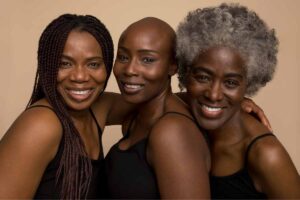
A Black Woman’s Prescription for Health: How To Navigate Health Disparities
Are you experiencing more menopause symptoms than your white friends or colleagues? Research backs up this experience. Learn about black woman’s health during menopause.

Black Women and Menopause: Why Symptoms Can Be Longer and More Severe
As a Black woman, menopause symptoms, including hot flashes, can be longer and more severe. Learn why and what you can do.
Hispanic Women | Latinas
 Hispanic women and Latinas are more likely to experience:
Hispanic women and Latinas are more likely to experience:
- shorter duration of sleep
- earlier age of onset of perimenopause
- longer transition duration than their white and Asian counterparts
- severe and frequent hot flashes (especially if living outside the U.S.)
- a greater relationship between VSM and depression
- GI symptoms (constipation, bloating, and weight gain)
- urogenital symptoms (vaginal dryness and painful intercourse)
- skin and hair changes
- mood swings, depression, and anxiety
- bladder issues and vaginal dryness
- joint and muscular discomfort
- “heart discomfort”
- increased risk of cardiovascular disease like heart attack and stroke due to genetic profile changes
They also tend to reach the post-menopause stage later in the journey.
Many of these findings were discussed during the 2022 North American Menopause Society Annual Meeting.
Hot flashes
A 2014 study showed Hispanic women living outside the U.S. were:
- 2.4 times more likely to have frequent and severe vasomotor symptoms
- 2.8 times more likely to have skin issues
There was also a link between education and parity. Those with higher education levels and fewer children (which in this study were those born in the U.S.), had fewer challenges with VSMs.
Variability also has been found across ethnic groups. Take a look at VSMs reported during the same time period by women in Central America vs. Cuba:
- 72% of Central American women reported VSMs
- 34% of Cuban women reported VSMs
Sleep
There were also differences regarding sleep issues. Although Latinas were less likely to report difficulty staying asleep and early morning awakenings, they had a higher prevalence of inconsistent sleep patterns, sleep “debt,” (not getting adequate sleep over a series of days) and both short sleep and insomnia symptoms than white women. Dominican and Puerto Rican women living in the U.S. had more sleep problems than other Latinas.
GI
Hispanic women are more likely to have higher severity scores for GI symptoms like constipation and bloating, as well as weight gain.
Urogenital
Latina women have a greater likelihood of experiencing urogenital symptoms, including:
- vaginal dryness
- painful intercourse
- urinary incontinence
- bladder problems
Central American and South American Hispanic women have worse symptoms than Caribbean Hispanic women.
Health risks
A systematic review of studies found Latinas to have a different hormonal transition profile than other racial/ethnic groups. It puts them at increased risk of atherosclerosis (build-up of plaque within the walls of arteries), which increases the likelihood of cardiovascular disease like heart attack and stroke.
Emotional concerns
Latinas also displayed a greater relationship between symptoms of depression and VSMs, with depressive symptoms often related to the negative impact menopause can have on sexual well-being.
Mindset
Mindset plays a pivotal role during menopause for all women+. That’s why pausitive health is helping you make a change for the better, as it truly can be a positive experience.
In a study of Hispanic women in the U.S., women fell into four main mindsets:
- “cambio de vida” (change of life)
- being silent
- being optimistic
- getting support
Do any of these sound like you? If so, knowing which one best describes your mindset might help you reflect on your experience and ways to improve it.
Push yourself outside your comfort zone, and if your attitude towards this normal stage of life is negative, know there are positive ways to think about menopause. Your perspective can impact your symptoms.
Cambio di vida (change of life)
Study participants viewed menopause as a normal life transition accompanied by physiologic changes which results in cessation of reproductive ability, some of which were viewed positively, like no longer having a monthly period.
Additionally, menopausal symptoms were judged to be a time-limited experience and one which was not the greatest challenge they had faced in their lives.
Women in the study indicated they approached menopause symptoms as a private matter and a time to wait things out with patience and without discussion with others, including their mothers.
Study participants tended to focus on making lifestyle adjustments to help address symptoms, with a particular emphasis on getting more rest.
Although women did not openly discuss the menopause transition, they reported their culture broadly viewed this time in a woman’s life as one during which more rest and the opportunity to relax were needed. As a result, they indicated feeling family support for engaging in a way that focused more on those needs, perhaps representing one of many benefits derived from “familismo.”
Talk about it
Be real with yourself and friends about your experience and how it may differ. The nonprofit, Let’s Talk Menopause, recently brought together leading experts to discuss The Truth About Race, Ethnicity, and Menopause Care and the reasons Black and Latina women have more severe symptoms.
You may also like…

How To Live Healthier: A Latina/Hispanic Woman’s+ Prescription For Health
The menopause journey is the perfect time to make a change for the better. Learn about Latina/Hispanic woman’s health, and get a prescription for better health.
Native American/Alaska Native Women
 Like others, the Native American community is diverse, with 574 federally recognized Indigenous Nations.
Like others, the Native American community is diverse, with 574 federally recognized Indigenous Nations.
The five largest Nations in the U.S., as of 2021 self-reported data, were the Navajo, the Cherokee, the Sioux, the Ojibwe (Chippewa), and the Choctaw.
In Alaska, geographically, there are the Eyak, Tlingit, Haida, Tsimshian peoples in the Southeast; the Yup’ik and Cup’ik Alaska Natives in the southwest; the Alutiiq (Sugpiaq) and Unangax peoples in south-central Alaska and the Aleutian Islands; the Inupiaq and St. Lawrence Island Yupik in the north and northwest; and the Athabascan peoples in Alaska’s interior.
Some studies report post-menopausal women are often viewed as “women of wisdom” within their communities.
That mindset affects a woman’s journey positively.
Still, Native American women experience vasomotor symptoms and at an earlier age.
VSMs
A 2017 study found that Native women were the most likely of all racial/ethnic groups to report vasomotor symptoms in the pre-menopause stage of life (the time between a woman’s first period and the onset of perimenopause).
In the SWAN study, Native women were also reported to have more hot flashes in their thirties and forties in the perimenopause phase of the journey than any racial/ethnic group.
Health risks
Menopause by itself puts women+ at greater risk for health conditions like osteoporosis and cardiovascular disease. When you have an earlier age of onset of menopause, which is more commonly the case in Alaska Native women, it increases the risk of other health conditions that much earlier.
Native women have a higher baseline rate of hypertension, heart disease, and osteoporosis. So, an earlier age of menopause onset further exacerbates the risk.
Undoubtedly, the health and well-being of Native women is impacted by the ravages of a history of invasion by foreign settlers and colonialism, which led to the takeover of Native lands and the establishment of reservations.
Although only 13% of the Native population in the continental U.S. lives on a reservation, the epigenetic (modifications to DNA that regulate whether genes are turned on or off that can persist for generations due to environmental factors and behavior patterns) effects on current generations of health disparities, including a higher rate of poverty, inadequate access to healthcare, and higher rates of conditions like heart disease, diabetes, and cancer all may contribute to the experience and negatively impact the menopause journey of Native women today.
Traditionally, Native culture is one in which there is respect for elders and the wisdom that comes with age. The result is a view of menopause that is often neutral to positive, with the menopause journey representing a transition to elder status and being a spiritual leader.
Some studies report that postmenopausal women are often viewed as ‘women of wisdom’ within their communities.
That mindset affects a woman’s journey positively. Still, Native American women experience vasomotor symptoms and perhaps at an earlier age.

Embrace a Healthier You: A Native American/Alaska Native Woman’s Prescription for Health
Embrace a healthier you, with this prescription for health for Native/Alaska Native women. Know the health risks, disparities, and prevention steps to live healthier.

Healthy Eating Tips From Around The World That Can Make Menopause Easier
Food as medicine. It can be as powerful as medicine for menopause symptoms. Get healthy eating tips from around the world to manage symptoms.
Asian Women
Broadly speaking, Asian women, regardless of ethnicity, tend to have a less challenging journey than those of other races. The medical literature generally indicates that Asian women have significantly fewer symptoms and the lowest total severity of symptoms of all racial groups. Though that may often be the case, there is a question as to whether the difference might sometimes be explained by fewer complaints made during visits with a healthcare provider.
However, that is not to say there are no issues or concerns. And certain symptoms have been found to be more common, both compared to other racial groups as well as across ethnic subgroups, of which there are more than 30 (with the Chinese, Indian, Filipino, Vietnamese, Korean, and Japanese communities among those with the greatest numbers in the U.S.).
For example, in the SWAN study, Japanese women were found to have a greater issue with sexual well-being than other Asian ethnic subgroups.
We’ll get to why this may be the case, but let’s first talk about what symptoms Asian women tend to experience.
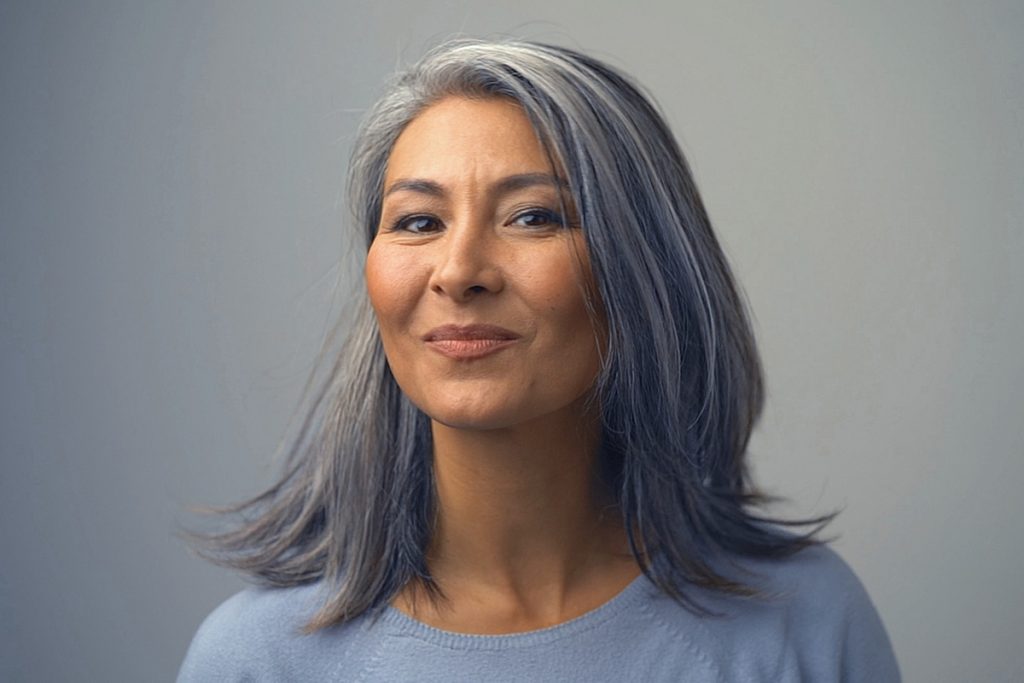
Menopause symptoms
A study of Asian American women in midlife found the most commonly reported symptoms across ethnic subgroups were (in descending order):
- Loss of libido
- Aches in the back of the neck and skull
- Forgetfulness
- Muscle and joint stiffness
The symptoms reported to be the most severe across ethnic subgroups were (in descending order):
- Forgetfulness
- Loss of libido
- Difficulty sleeping
- “Worrying about body”
- Aches in the back of neck and skull
However, there were differences when symptoms were studied by ethnic group. For example, Filipino women were noted to have significantly higher severity scores for menopausal symptoms (both physical and emotional/mental health) than Korean women.
With regard to the most severe symptoms, there were also differences:
- Forgetfulness – Chinese and Korean women
- Exhaustion/fatigue – Indian women
- Difficulty sleeping – Filipino women
- Loss of libido – “others”
The approach to management of symptoms also differed across ethnic groups:
- Chinese women – seeking guidance from a physician
- Korean, Filipino, and “other” Asian women – taking medication
- Indian women – “being mentally strong”
Studies of Asian immigrant women are inconsistent, with some publications indicating fewer and less severe symptoms and others reporting symptoms of a similar number and severity as white women.
Factors Impacting the Menopause Journey Experience
| Factor | More Challenging | Less Challenging |
|---|---|---|
| lower income | ||
| lower employment status | ||
| lesser degree of acculturation | ||
| being obese | ||
| poorer health status | ||
| surgical menopause | ||
| higher perceived level of stress | ||
| smoking | ||
| being physically active | ||
| social support | ||
| having information |
Additional factors included age and country of birth. Interestingly, contrary to what is typically reported to be the case, those with a higher BMI tended to have more VSMs. And the degree of acculturation had a variable impact in some cases. Greater acculturation was associated with more symptoms and a more negative attitude toward menopause, but in others, it had the opposite effect.
Immigrant women in the post-menopausal stage of the transition were also more likely to report symptoms like muscle, joint, and back pain and less likely to report VSMs.
It is unclear what impact the history of internment of the Japanese population in the 1940s may have on the health and well-being of Japanese women in the U.S. today.
And the rise in racist hate and violence against the Asian population during the COVID-19 pandemic has resulted in trauma that may impact the menopause journey. It is the latest example of a continuing history of racism and discrimination in the U.S. against the Asian community.
 Why fewer symptoms?
Why fewer symptoms?
Several reasons have been theorized as possible explanations for why Asian women have fewer symptoms. They include:
- cultures in which social status increases with age and the presence of positive attitudes toward aging, with menopause viewed as a normal part of the aging process
- eating habits, including a higher intake of soy and less fat consumption
- the possibility that Asian women (like many women regardless of race/ethnicity) are not reporting their symptoms (or are not being asked questions about menopausal symptoms by providers) and therefore underestimation in the medical literature of the menopause journey experience of Asian women when it comes to symptoms
An analysis of 17 studies found the women (Chinese, Korean, Filipino, Indian, and “others”) in the study had a generally neutral to positive attitude toward menopause.
However, the SWAN study indicated that some Asian women living in the U.S. viewed menopause less positively than their Western counterparts, with the hypothesis being a high degree of acculturation. In the U.S., menopause is traditionally viewed negatively and a sign of aging which is also typically viewed negatively.

Unlocking Your Best Health: An Asian Woman’s Prescription During the Menopause Journey
Learn about the health risks for Asian women+ during menopause.

Foods For Menopause: 9 Best Foods To Help Menopause
Did you know you can manage your menopause symptoms with food? Learn the 10 best foods packed with the necessary nutrients to feel better.
Native Hawaiian & Pacific Islander Women
 Native Hawaiian and Pacific Islander women tend to experience menopause at an earlier age.
Native Hawaiian and Pacific Islander women tend to experience menopause at an earlier age.
An earlier age of onset means an earlier start to the increased risk of hypertension, heart disease, stroke, diabetes, depression, anxiety, and osteoporosis, which develops as a result of the hormonal shifts that occur during the menopause transition.
The Hilo Women’s Health Study is working to further the understanding of how menopause affects the diverse population of Hilo, including Native Hawaiians, Pacific Islanders, and Asian women+.
In the study, Native Hawaiian and Pacific Islander women were found to have:
- Lower total cholesterol but also lower HDL (“good” cholesterol) levels
- Higher triglyceride levels
The lipid profile above would increase the risk of cardiovascular disease, a condition for which this group of women is already at increased risk.
The researchers pointed out that doctors often prescribe hormone therapy to help women during menopause as estrogen decreases. HT can reduce the severity of symptoms like hot flashes, mood swings, and sleep issues. It also has the potential to reduce the risk of heart disease. So, if you are already taking HT for menopausal symptoms, you may get this additional benefit.
The reduced risk has been found in those younger than 60 and/or within less than 10 years of reaching menopause. Otherwise, HT could actually increase the risk.
As always, it’s important to speak with your medical practitioner to determine if HT would be of benefit in your particular situation.
Traditional diets can help
Historical context
Menopause symptoms may vary among Native Hawaiian and Pacific Islander women, as it’s a diverse community. It includes those with ancestry of original peoples of the following geographic locales:
- Polynesia – Hawaii and Samoa
- Micronesia – Guam, the Republic of Palau, the Northern Mariana islands, the Federated states of Micronesia, the Republic of the Marshall Islands
- Melanesia – Fiji, Tonga
Like Native American and Native Alaskan women, the Native Hawaiian and Pacific Islander population also experiences the epigenetic impact and health disparities which result from a history of colonialism, in addition to the devastation caused by a system that introduced exposure to infectious diseases like tuberculosis, measles, and smallpox.
Learn more through the lens of history and Hawaiian culture from Makana Kāne Kuahiwinui, who did a Master’s thesis on the natural life cycle of women, “Menstruation, Menopause & Hawaiian Culture.”

Elevate Your Well-Being: A Native Hawaiian and Pacific Islander Woman’s Prescription
This “prescription for health” for a Native Hawaiians and Pacific Islander woman+ provides the information you need to live a healthier and perhaps longer life.
Menopause Around the World
It’s important to note that when an individual moves to another country, the menopause experience may become more like the country to which the move occurred rather than the prior country of residence or origin.
For example, immigrant women of color in the U.S. may have a different menopause journey experience than those who have been born in or lived in the U.S. for decades.
So, whether you’re just embarking on or in the midst of your menopause journey, it can be very helpful to understand how menopause is the same and different throughout the world.
If you look at studies from around the globe, certain patterns emerge that seem to be universal.
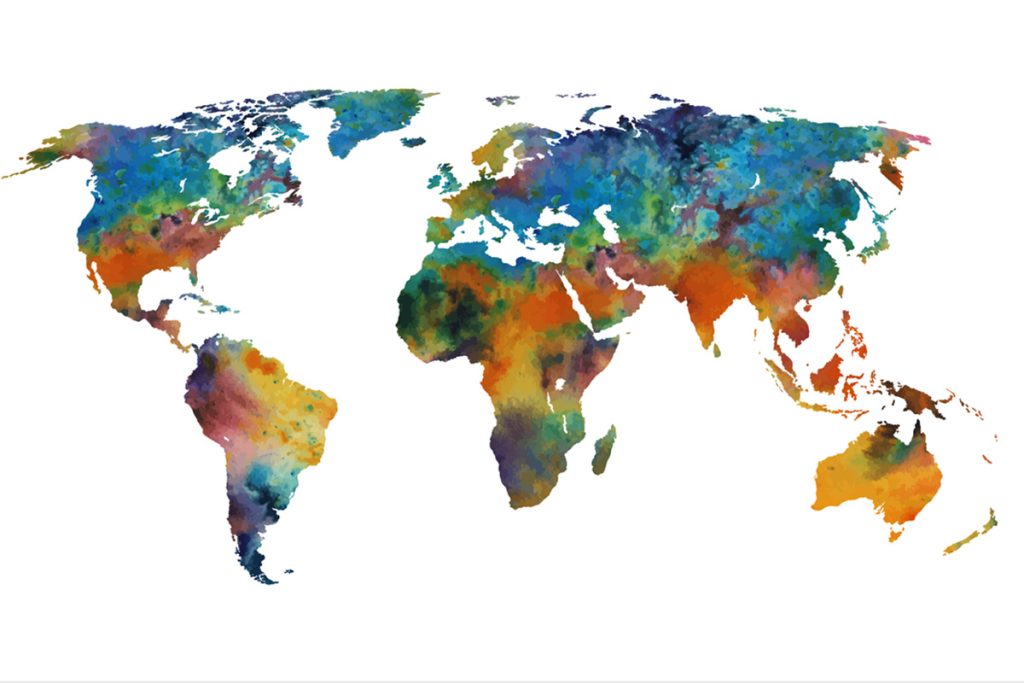
Menopause definition
- Natural menopause onset is marked by 12 consecutive months without a period.
- Clinical circumstances can also cause menopause.
How it impacts women
- Virtually all parts of the body can be impacted by menopause symptoms.
- The hormonal changes increase the risk of cardiovascular disease, osteoporosis, internal abdominal fat around the organs (aka visceral fat), urinary incontinence, vaginal atrophy leading to an increased likelihood of UTIs and pain during intercourse, depression, and anxiety, and dementia in those with premature and early menopause.
- An earlier age of onset of menopause means you’re at risk for conditions like heart disease and osteoporosis (falls and fractures) for a longer period of time.
- Sleep issues related to the transition tend to increase over the course of the menopause journey.
Symptom causes: hormones and menstrual history
- Symptoms are caused by hormonal shifts, with the plummet in estrogen levels the main driver. Additional contributory factors include a drop in progesterone levels, a change in the ratio of estrogen, progesterone, and testosterone, and the volatility of the hormonal swings.
- Having a first period earlier than age 14 can result in a 2X greater risk of vasomotor symptoms (VSMs) – hot flashes, night sweats, and palpitations.
- Having a history of shorter menstrual cycles can lead to (1) higher rates of all menopausal symptoms, (2) more severe sleep, cardiac, and depression symptoms, and (3) menopause onset at an earlier age.
Lifestyle and health history influencing symptoms
- Moderate to heavy alcohol use increases the likelihood of having symptoms.
- Smoking increases the likelihood of an earlier age of onset menopause, having symptoms (particularly VSMs), and a shorter duration of the menopause transition.
- Having greater parity (pregnancy resulting in a viable fetus) and prior BCP use can lead to a later age of onset of menopause.
- Having certain underlying conditions – depression, anxiety, obesity – increase the likelihood of symptoms in general and VSMs in particular.
- Obesity increases the likelihood of VSMs early in the transition but reduces the likelihood of those symptoms in the post-menopause stage.
COVID-19 impact
- COVID-19 infection can impact the ovaries in a way that reduces estrogen levels and can lead to both more severe symptoms and potentially more acute onset of perimenopausal symptoms and onset of menopause.
- Long COVID, which is more common in women, can cause changes in the nature of periods (flow, frequency, duration) during perimenopause.
- The hormonal changes which occur during perimenopause can worsen pre-existing long COVID symptoms.
- HT (hormone therapy) may potentially help mitigate the impact of COVID in women with perimenopausal symptoms (HT is still being studied in this context.)
- Some of the symptoms of long COVID and the menopause journey may overlap, e.g., brain fog, sleep issues, fatigue, emotional distress, which can make assessment more complicated and challenging.
Social Determinants of Health (SDOH)
- Financial instability and lower socioeconomic status, including education level, can increase the likelihood and severity of symptoms.
- A history of abuse/trauma can increase the severity of symptoms and makes it more likely vasomotor symptoms (VSMs) like hot flashes and night sweats will be dominant symptoms.
- Geographic locale can impact the type, number, frequency, and severity of symptoms.
Solutions
- Living a healthy lifestyle – adequate levels of physical activity, healthy eating, sleep of adequate duration and quality, a social network of support and community, coping skills to manage life stressors, and self-care – can have a positive impact on the experience women+ have during the menopause journey and can reduce some of the risks associated with the hormonal transitions which occur.
Geographic differences
While there are many similarities, there are just as many differences among countries and regions within a country. As you travel on this journey of menopause, and prepare for what to expect, it’s important to understand all the converging factors that can influence your experience.
With wide-ranging symptoms and experiences, menopause can be a journey of self-exploration as well as a time to develop greater self-awareness and take positive action to make a change for the better.
Continue learning about how menopause varies based on “where” a woman lives. We explore how it varies by country, continent, and regions across the world like Africa, Canada, China, Japan, India, Israel, Mexico, Central America, Middle East, Scandinavia, Switzerland, Central and South America, and the United States.
If you look at studies from around the globe, certain patterns emerge that seem to be universal.
Join us in being a pioneer
Although research on menopause is increasing, funding and resources for and focus on women’s health in general continues to be woefully inadequate. And within the arena of women’s health, the situation is even worse when it comes to both the menopause journey and women of color.
As is often the case, when it comes to women’s health issues, women+ are the ones who frequently find themselves leading the charge to make the system work to address their needs and make changes from a historical perspective that has often treated women+ as a variation on a theme of findings from research studies on men. pausitive health hopes to contribute to the knowledge and understanding of the menopause journey and life beyond the transition. We hope you’ll join us as pioneers!
If you become aware of information that is pertinent to the topic, we hope you will share it with us, so we can use it to make others aware and help us better address the needs of women+ moving through this stage of life.
Likewise, if you find anything we have shared which we believe to be accurate to the best of our knowledge at a given point in time, but which misses the mark, we ask that you let us know so we can make any necessary corrections promptly.
Contact us at info@pausitivehealth.com
Disclaimer: As is always the case in any population, the findings extracted from the literature and outlined in this article are not intended by pausitive health to imply that they apply to all women+ of the groups and cultures discussed.
Find a Menopause Practitioner | The North American Menopause Society
Faleschini, Sabrina PhD1; Tiemeier, Henning MD, PhD2; Rifas-Shiman, Sheryl L. MPH1; Rich-Edwards, Janet ScD, MPH3,4,5; Joffe, Hadine MD, MSc5,6; Perng, Wei PhD, MPH7; Shifren, Jan MD, NCMP8; Chavarro, Jorge E. ScD, MD3,9; Hivert, Marie-France MD, MMSc1,10; Oken, Emily MD, MPH1,9. Longitudinal associations of psychosocial stressors with menopausal symptoms and well-being among women in midlife. Menopause 29(11):p 1247-1253, November 2022. | DOI: 10.1097/GME.0000000000002056
Yamnia I. Cortés, Valentina Marginean, Key factors in menopause health disparities and inequities: Beyond race and ethnicity, Current Opinion in Endocrine and Metabolic Research, Volume 26, 2022, 100389, ISSN 2451-9650. https://doi.org/10.1016/j.coemr.2022.100389.
Disparities in the Menopause Transition | The North American Menopause Society [YouTube]
Kling JM, MacLaughlin KL, Schnatz PF, Crandall CJ, Skinner LJ, Stuenkel CA, Kaunitz AM, Bitner DL, Mara K, Fohmader Hilsaca KS, Faubion SS. Menopause Management Knowledge in Postgraduate Family Medicine, Internal Medicine, and Obstetrics and Gynecology Residents: A Cross-Sectional Survey. Mayo Clin Proc. 2019 Feb;94(2):242-253. doi: 10.1016/j.mayocp.2018.08.033. PMID: 30711122.
McKnight KK, Wellons MF, Sites CK, Roth DL, Szychowski JM, Halanych JH, Cushman M, Safford MM. Racial and regional differences in age at menopause in the United States: findings from the Reasons for Geographic And Racial Differences in Stroke (REGARDS) study. Am J Obstet Gynecol. 2011 Oct;205(4):353.e1-8. doi: 10.1016/j.ajog.2011.05.014. Epub 2011 May 14. PMID: 21663888; PMCID: PMC3202084.
Understanding Racial Terms and Differences | National Institutes of Health
Alanna De Mello, Augustine Chavez, Mahnoor Mukarram, Matthew R. Buras, Juliana M. Kling. Menopausal symptoms in the Southwest United States: A cross-sectional survey of women from areas with different socioeconomic resources. Maturitas. Volume 154, 2021, Pages 7-12,ISSN 0378-5122, https://doi.org/10.1016/j.maturitas.2021.08.110.
Mirin AA. Gender Disparity in the Funding of Diseases by the U.S. National Institutes of Health. J Womens Health (Larchmt). 2021 Jul;30(7):956-963. doi: 10.1089/jwh.2020.8682. Epub 2020 Nov 27. PMID: 33232627; PMCID: PMC8290307.
Aninye IO, Laitner MH, Chinnappan S; Society for Women’s Health Research Menopause Working Group. Menopause preparedness: perspectives for patient, provider, and policymaker consideration. Menopause. 2021 Jun 28;28(10):1186-1191. doi: 10.1097/GME.0000000000001819. PMID: 34183564; PMCID: PMC8462440.
Women’s Health In Focus at NIH | NIH Office of Research on Women’s Health 2022
Black, Hispanic Persons Are More Likely to Report Severe Menopause Symptoms | ClinicalAdvisor
Menopause Rating Scale | Millenium Wellness Center
Harlow, S.D., Burnett-Bowie, SA.M., Greendale, G.A. et al. Disparities in Reproductive Aging and Midlife Health between Black and White women: The Study of Women’s Health Across the Nation (SWAN). Women’s Midlife Health 8, 3 (2022). https://doi.org/10.1186/s40695-022-00073-y
Marcianna Nosek, Holly Powell Kennedy, Yewoubdar Beyene, Diana Taylor, Catherine Gilliss, Kathryn Lee.
The Effects of Perceived Stress and Attitudes Toward Menopause and Aging on Symptoms of Menopause.
Journal of Midwifery & Women’s Health, Volume 55, Issue 4, 2010, Pages 328-334, ISSN 1526-9523, https://doi.org/10.1016/j.jmwh.2009.09.00.
The Growing Diversity of Black America | Pew Research Center
What Part of Africa Did Most Enslaved People Come From? | History
Geronimus AT, Hicken MT, Pearson JA, Seashols SJ, Brown KL, Cruz TD. Do US Black Women Experience Stress-Related Accelerated Biological Aging?: A Novel Theory and First Population-Based Test of Black-White Differences in Telomere Length. Hum Nat. 2010 Mar 10;21(1):19-38. doi: 10.1007/s12110-010-9078-0. PMID: 20436780; PMCID: PMC2861506.
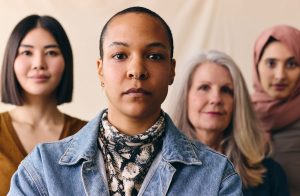
Menopause Around the World: How Symptoms & Mindsets Vary
1.2 billion women+ across the globe will be on the menopause journey by 2030. Source: The Demography of Menopause | Maturitas Menopause Around the World: Country by Country Guide Every woman’s menopause journey is unique. While there are symptoms like vasomotor symptoms (hot flashes, night sweats, and palpitations) which 80% of women+ in the U.S.

Change How You Feel During Menopause With These Blue Zone Tips For Aging
Do you want to live a long healthy life disease free? It happens around the world. Change how you feel during menopause with these Blue Zone tips.

Healthy Eating Tips From Around The World That Can Make Menopause Easier
Food as medicine. It can be as powerful as medicine for menopause symptoms. Get healthy eating tips from around the world to manage symptoms.



